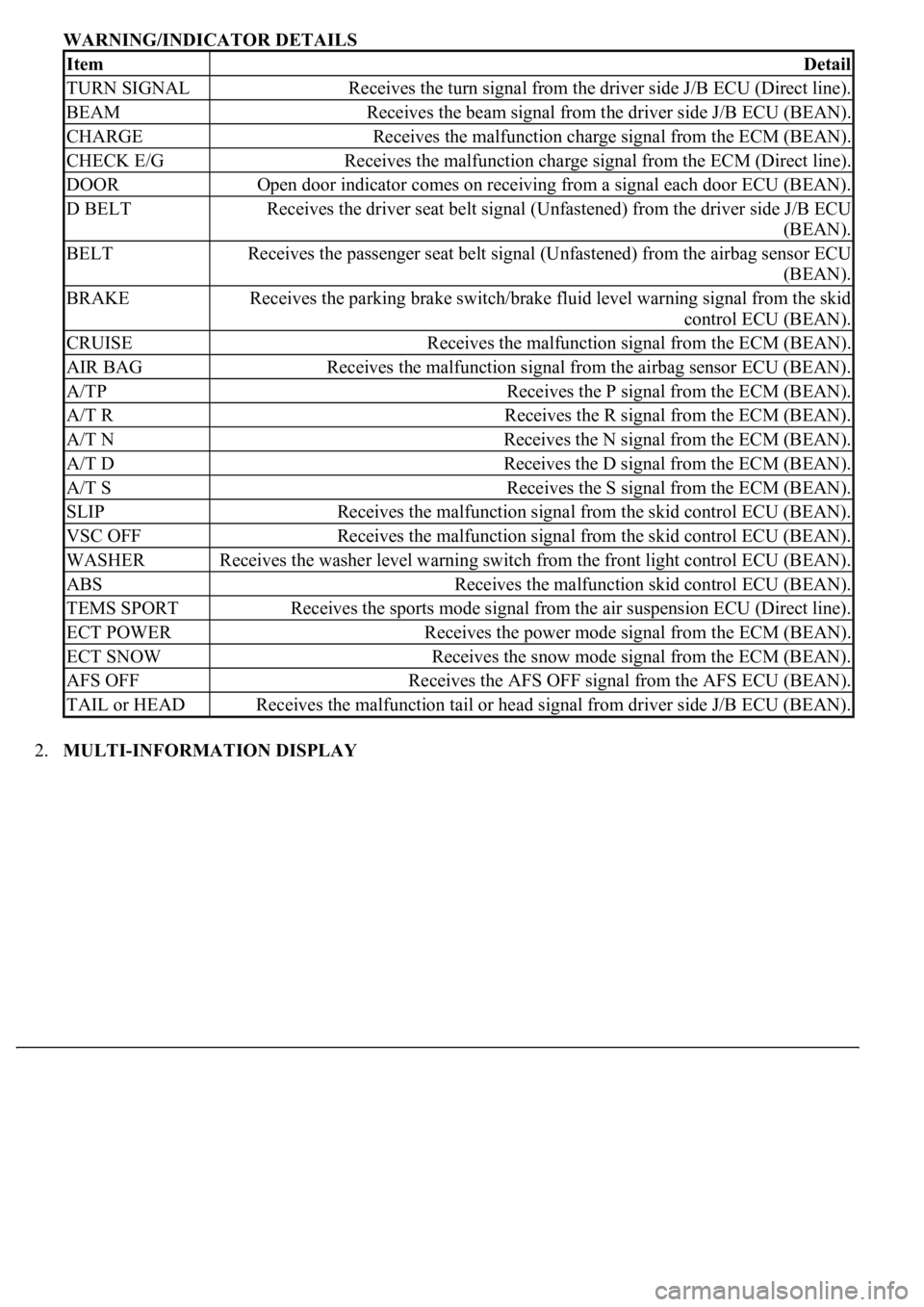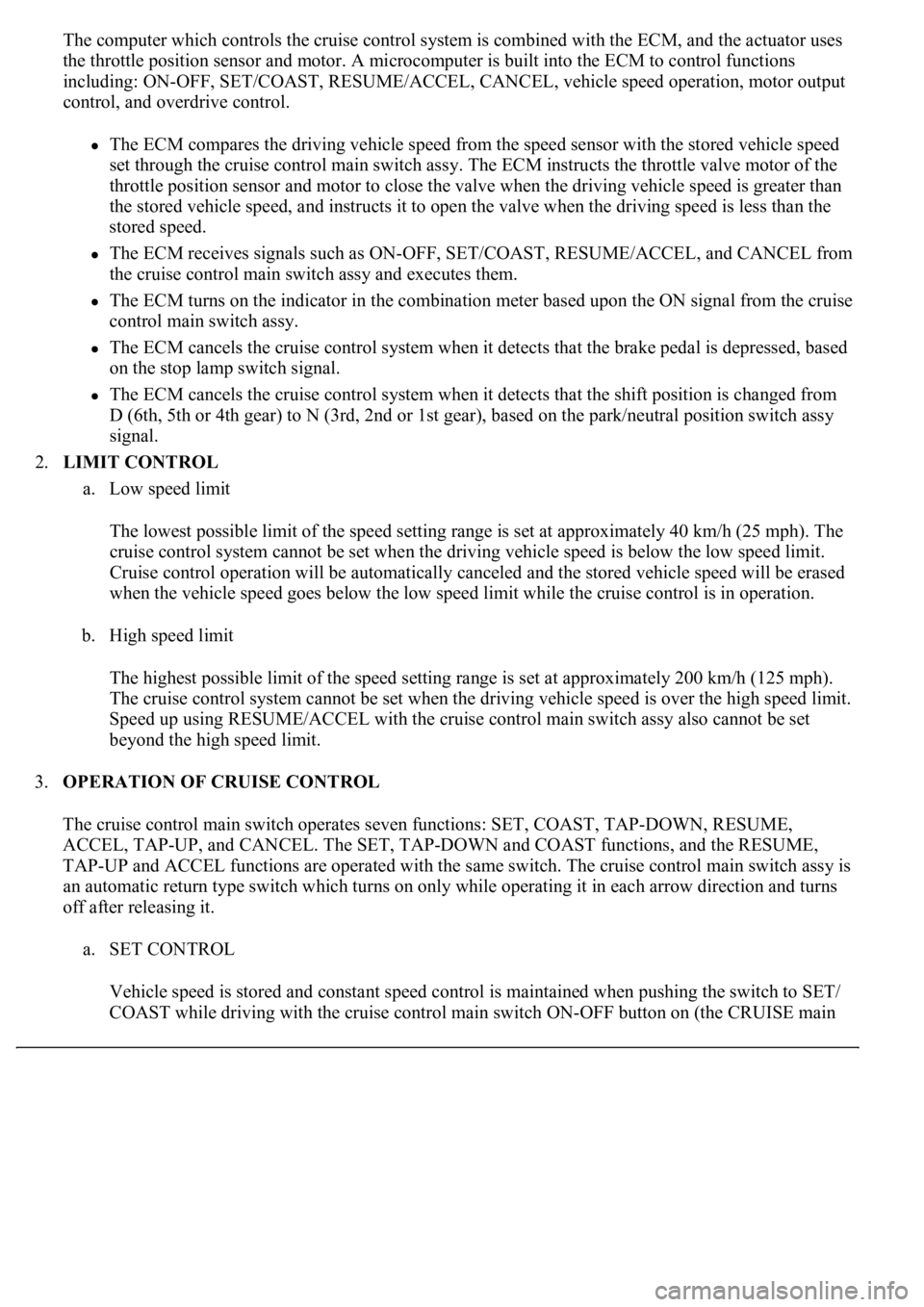Page 1099 of 4500
Fig. 128: Installing Skid Control Sensor Onto Hub & Bearing Assy
Courtesy of TOYOTA MOTOR SALES, U.S.A., INC.
8.INSTALL FRONT AXLE HUB SUB-ASSY LH (SEE REPLACEMENT
)
9.INSTALL FRONT DISC (SEE COMPONENTS
)
10.INSTALL FRONT DISC BRAKE CALIPER ASSY LH (SEE OVERHAUL
)
11.CONNECT SKID CONTROL SENSOR WIRE
a. Connect the skid control sensor connector.
Page 1131 of 4500
Fig. 158: Removing Nuts And Yawrate Sensor
Courtesy of TOYOTA MOTOR SALES, U.S.A., INC.
33.REMOVE CONSOLE BOX DUCT NO.1 (SEE REPLACEMENT
)
34.REMOVE OXYGEN SENSOR (SEE REPLACEMENT
)
35.REMOVE EXHAUST PIPE ASSY (SEE REPLACEMENT
)
36.REMOVE FRONT FLOOR HEAT INSULATOR NO.1 (SEE REPLACEMENT
)
37.REMOVE FLOOR SHIFT GEAR SHIFTING ROD SUB-ASSY (SEE OVERHAUL
)
38.REMOVE FLOOR SHIFT ASSY (SEE OVERHAUL
)
39.REMOVE PARKING BRAKE CABLE ASSY NO.1
a. Release the parking brake pedal.
b. Remove the return spring.
c. Remove the 2 bolts and separate the parking brake intermediate lever sub-assy from the floor panel.
d. Remove the clip and pin, and separate the parking brake cable assy No.1 from the parking brake
intermediate lever sub-assy.
e. Remove the 2 bolts and disconnect the parking brake cable No.2 and No.3 from the parking brake
intermediate lever sub-ass
y.
Page 1141 of 4500
Fig. 168: Installing Parking Brake Intermediate Lever Sub-Assy To Floor Panel With Bolts
Courtesy of TOYOTA MOTOR SALES, U.S.A., INC.
41.INSTALL YAWRATE SENSOR
a. Install the yawrate sensor with the 2 nuts.
Torque: 14 N.m (142kgf.cm, 10 ft.lbf)
Page 1147 of 4500
73.INSPECT PARKING BRAKE PEDAL TRAVEL (SEE ADJUSTMENT )
74.ADJUST PARKING BRAKE PEDAL TRAVEL (SEE ADJUSTMENT
)
75.INSTALL INSTRUMENT PANEL UNDER COVER SUB-ASSY NO.2 (SEE REPLACEMENT
)
76.INSTALL INSTRUMENT PANEL AIR BAG ASSY LOWER NO.1 (SEE REPLACEMENT
)
77.INSTALL INSTRUMENT PANEL SAFETY PAD SUB-ASSY NO.1 (SEE REPLACEMENT
)
78.INSTALL OUTER MIRROR SWITCH ASSY
79.INSTALL COIN BOX ASSY
80.INSTALL INSTRUMENT PANEL UNDER COVER SUB-ASSY NO.1 (SEE REPLACEMENT
)
81.INSTALL INSTRUMENT CLUSTER FINISH PANEL CENTER LOWER
82.INSTALL INSTRUMENT CLUSTER FINISH PANEL END
83.CONNECT BATTERY NEGATIVE TERMINAL
84.INSPECT SRS WARNING LIGHT (SEE DIAGNOSIS SYSTEM
)
85.CHECK FOR EXHAUST GAS LEAKS
86.PERFORM YAWRATE SENSOR ZERO POINT CALIBRATION (SEE CALIBRATION
)
87.PERFORM INITIALIZATION (SEE INITIALIZATION
)
COMPONENTS
Page 1155 of 4500
Fig. 180: Disconnecting Parking Brake Cable Assy No.3 From Parking Brake Shoe Lever
Courtesy of TOYOTA MOTOR SALES, U.S.A., INC.
8.REMOVE OXYGEN SENSOR (SEE REPLACEMENT
)
9.REMOVE EXHAUST PIPE ASSY (SEE REPLACEMENT
)
10.REMOVE FRONT FLOOR HEAT INSULATOR NO.1 (SEE REPLACEMENT
)
11.REMOVE PARKING BRAKE CABLE ASSY NO.3
a. Remove the 2 nuts and parking brake cable assy No.3 from the rear axle carrier.
Page 1168 of 4500
j.INSTALL REAR WHEEL
Torque: 103 N.m (1,050 kgf.cm, 76 ft.lbf)
k.INSTALL FRONT FLOOR HEAT INSULATOR NO.1 (SEE REPLACEMENT
)
l.INSTALL EXHAUST PIPE ASSY (SEE REPLACEMENT
)
m.INSTALL OXYGEN SENSOR (SEE REPLACEMENT
)
n.SETTLING PARKING BRAKE SHOES AND DISC
a. Drive the vehicle at approximately 50 km/h (31 mph) on a safe, level and dry road.
b. Depress the parking brake pedal with a force of 150 N (15 kgf.cm, 34 lbf).
c. Drive the vehicle for approximately 400 meters (0.25 mile) in this condition.
d. Repeat this procedure 2 or 3 times.
o.CHECK PARKING BRAKE PEDAL TRAVEL (SEE ADJUSTMENT
)
p.ADJUST PARKING BRAKE PEDAL TRAVEL (SEE ADJUSTMENT
)
COMPONENTS
Page 1744 of 4500

WARNING/INDICATOR DETAILS
2.MULTI-INFORMATION DISPLAY
ItemDetail
TURN SIGNALReceives the turn signal from the driver side J/B ECU (Direct line).
BEAMReceives the beam signal from the driver side J/B ECU (BEAN).
CHARGEReceives the malfunction charge signal from the ECM (BEAN).
CHECK E/GReceives the malfunction charge signal from the ECM (Direct line).
DOOROpen door indicator comes on receiving from a signal each door ECU (BEAN).
D BELTReceives the driver seat belt signal (Unfastened) from the driver side J/B ECU
(BEAN).
BELTReceives the passenger seat belt signal (Unfastened) from the airbag sensor ECU
(BEAN).
BRAKEReceives the parking brake switch/brake fluid level warning signal from the skid
control ECU (BEAN).
CRUISEReceives the malfunction signal from the ECM (BEAN).
AIR BAGReceives the malfunction signal from the airbag sensor ECU (BEAN).
A/TPReceives the P signal from the ECM (BEAN).
A/T RReceives the R signal from the ECM (BEAN).
A/T NReceives the N signal from the ECM (BEAN).
A/T DReceives the D signal from the ECM (BEAN).
A/T SReceives the S signal from the ECM (BEAN).
SLIPReceives the malfunction signal from the skid control ECU (BEAN).
VSC OFFReceives the malfunction signal from the skid control ECU (BEAN).
WASHERReceives the washer level warning switch from the front light control ECU (BEAN).
ABSReceives the malfunction skid control ECU (BEAN).
TEMS SPORTReceives the sports mode signal from the air suspension ECU (Direct line).
ECT POWERReceives the power mode signal from the ECM (BEAN).
ECT SNOWReceives the snow mode signal from the ECM (BEAN).
AFS OFFReceives the AFS OFF signal from the AFS ECU (BEAN).
TAIL or HEADReceives the malfunction tail or head signal from driver side J/B ECU (BEAN).
Page 1904 of 4500

The computer which controls the cruise control system is combined with the ECM, and the actuator uses
the throttle position sensor and motor. A microcomputer is built into the ECM to control functions
including: ON-OFF, SET/COAST, RESUME/ACCEL, CANCEL, vehicle speed operation, motor output
control, and overdrive control.
The ECM compares the driving vehicle speed from the speed sensor with the stored vehicle speed
set through the cruise control main switch assy. The ECM instructs the throttle valve motor of the
throttle position sensor and motor to close the valve when the driving vehicle speed is greater than
the stored vehicle speed, and instructs it to open the valve when the driving speed is less than the
stored speed.
The ECM receives signals such as ON-OFF, SET/COAST, RESUME/ACCEL, and CANCEL from
the cruise control main switch assy and executes them.
The ECM turns on the indicator in the combination meter based upon the ON signal from the cruise
control main switch assy.
The ECM cancels the cruise control system when it detects that the brake pedal is depressed, based
on the stop lamp switch signal.
The ECM cancels the cruise control system when it detects that the shift position is changed from
D (6th, 5th or 4th gear) to N (3rd, 2nd or 1st gear), based on the park/neutral position switch assy
signal.
2.LIMIT CONTROL
a. Low speed limit
The lowest possible limit of the speed setting range is set at approximately 40 km/h (25 mph). The
cruise control system cannot be set when the driving vehicle speed is below the low speed limit.
Cruise control operation will be automatically canceled and the stored vehicle speed will be erased
when the vehicle speed goes below the low speed limit while the cruise control is in operation.
b. High speed limit
The highest possible limit of the speed setting range is set at approximately 200 km/h (125 mph).
The cruise control system cannot be set when the driving vehicle speed is over the high speed limit.
Speed up using RESUME/ACCEL with the cruise control main switch assy also cannot be set
beyond the high speed limit.
3.OPERATION OF CRUISE CONTROL
The cruise control main switch operates seven functions: SET, COAST, TAP-DOWN, RESUME,
ACCEL, TAP-UP, and CANCEL. The SET, TAP-DOWN and COAST functions, and the RESUME,
TAP-UP and ACCEL functions are operated with the same switch. The cruise control main switch assy is
an automatic return type switch which turns on only while operating it in each arrow direction and turns
off after releasing it.
a. SET CONTROL
Vehicle speed is stored and constant speed control is maintained when pushing the switch to SET/
COAST while drivin
g with the cruise control main switch ON-OFF button on (the CRUISE main